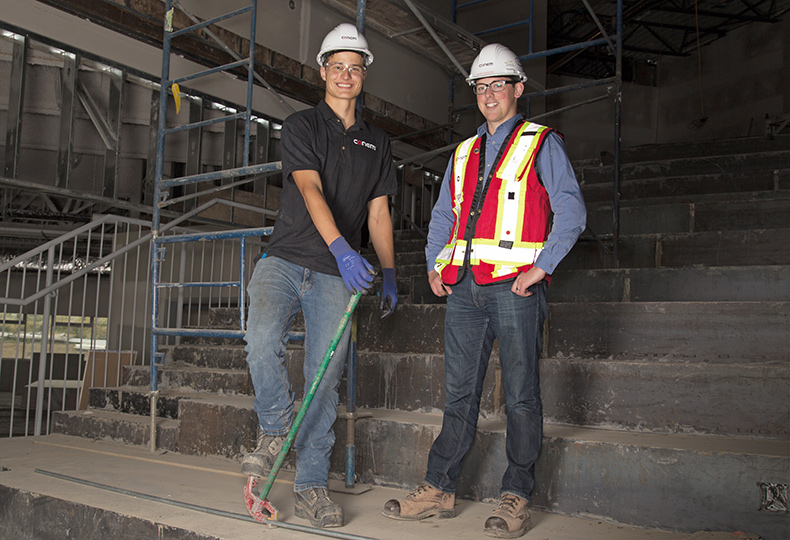Ready for Work
Young people are finding their feet in the trades thanks to Careers: The Next Generation and the Registered Apprenticeship Program
by Willow White

High school students and young adults make up an important component of the construction industry, but false stereotypes can be barriers to young workers, pigeonholing them as lazy, careless and always on their cellphones. Of course, these labels don’t accurately represent young workers. Without the same experience as a veteran worker, younger people aren’t always equipped with the knowledge to be totally safe on the work site – through no fault of their own. They need training and mentorship. That’s where Careers: The Next Generation comes in.
– Dustin Christensen, operations manager,
Canem Systems Ltd.
The primary role of Careers is to bring together Alberta students and employers by providing hands-on experience in the trades through internships, summer camps and co-op programs. Each year, Careers partners with more than 500 high schools in the province to provide these programs. Specifically, Careers identifies which industries are in need of skilled workers. Careers then identifies what kind of educational program may be best for a student. For example, high school students interested in jobs in the health care sector can participate in a three-day summer camp, where they will tour labs and medical facilities, hear from professionals and learn about various education programs available in the province. Alternatively, students looking for a more long-term commitment can start a Registered Apprenticeship Program (RAP) or co-op program while in school.
Carmen Wyton is the vice-president of stakeholder relations and partnerships for Careers. She’s passionate about making the trades more accessible to young people, especially high school students. Wyton doesn’t believe that students are inherently unsafe, but that they need access to hands-on experience to make good career decisions that traditional high schools don’t always offer. “Often, students we work with are not being engaged in high school because what really fulfills them isn’t being offered,” says Wyton. “So, when we can introduce [students] to the trades and they can get paid internships and site-based work experience, their whole education experience becomes much more relevant.”
There are many positive outcomes of Careers programs that are not immediately obvious. “Students in our programs graduate,” Wyton says. “It really is that simple.” Furthermore, students have access to a fair wage. “To be part of the program, the employer has to be willing to pay a competitive wage. The student is collecting hours for their apprenticeship, they are collecting credits toward their diploma, and they are earning a competitive wage.” This experience ultimately provides young people with a taste of what having a long-term career is like.
While Careers provides great opportunities for students, the benefit to employers is significant as well. Alberta faces a shortage of skilled workers, but employers who participate in Careers are getting ahead by being a key element of training new, young workers.
For employers looking to hire young employees, one of the biggest barriers can be the lack of safety training that a younger person has received. Wyton explains that while many employers want to hire younger people, they can’t justify the expense of safety training – not to mention the lost productivity that employers face when young workers require more training. On the other hand, students may lose weeks of hands-on experience because this extra training is needed.
As a solution, Careers teamed up with the Alberta Construction Safety Association (ACSA) to create an initiative called Safe Under 18. The program provides safety information to students, employers, parents and schools to help bust myths about workplace safety.
Safe Under 18 provides a survey for students, parents and employers to give feedback about their experience with safety in the workplace. These surveys provide information that helps improve safety parameters – though Careers employers already have a pristine safety track record. “We do not have a reported lost-time or disabling injury among any of our RAP and co-op students,” says Wyton. This information should be a comfort to parents. While some may be wary of allowing their high school-aged child to work on a construction site, Wyton – whose son and daughter both work in trades – is quick to assure parents that safety is the priority of all Careers employers. “The organizations we work with have a high level of safety consciousness.”

Wyton also explains that when unsafe behaviour happens on a work site involving a young person, it’s not necessarily the young person’s sole responsibility. “When young people are asked to do something they’re not prepared for, they need to have the courage to say ‘No.’ ” This isn’t always easy, and takes patience on the part of the employer.
That’s why Safe Under 18 created a creed for students to help them understand and take responsibility for their own safety on site. The creed centres around three values: awareness, behaviour and confidence. Awareness involves making sure you’re prepared, trained and oriented. Behaviour means listening carefully and focusing on the task at hand. Confidence ranges from saying no to a task for which you’re not trained to asking lots of questions.
– Carmen Wyton, vice-president of stakeholder relations and partnerships,
Careers: The Next Generation
Dustin Christensen has first-hand knowledge of what it means to be young and safe on the work site. Thirteen years ago, Christensen was part of the RAP through Careers. He started in the summer of Grade 10 with a residential electrical program, and eventually switched to a commercial electrical company. He has been with the same company ever since. Today, Christensen is in a unique position to offer advice to current high school students of the long-term benefits of pursuing the trades.
Christensen says that young workers are not inherently unsafe or careless but that they need more experienced workers to walk alongside them. “It’s an education,” he says. “We give them safety training and orientation.” First, students are required to take the basic Construction Safety Training System (CSTS) program, which is often provided by high schools in the province. But that’s really the bare minimum. “Before [students] go out on the job site, there are rules we let them know about.” For example, phones are off-limits. Christensen admits that, of course, it’s possible to catch a student on a cellphone when they shouldn’t be, but that they learn quickly. “They’re good once you tell them the rules. They listen. They get it,” he says.
Like Wyton, Christensen sometimes has to help parents understand that their kids will be safe. “There are lots of parents that don’t think [on site] is the right place for a kid to work,” he says. “We just make them aware that we are not throwing kids hand tools and sending them up an eight-foot ladder. We teach them how to work safely. They work very closely with the journeyman electrician or someone else who is very capable.”
The long-term benefits of starting in the trades early can be huge. Christensen explains that he finished high school much earlier than his peers and was able to get a jump start on his career. “I actually graduated in January of my graduation year. … When we had our graduation ceremony, I was officially a second-year electrician. I had a one-year head start.”
Meanwhile, Gavin Rittammer is a 17-year-old currently enrolled in the RAP who wants to become an electrician. He says he has learned so much from his mentors in the program, especially about safety on the job site.
“We make sure we’re using three-point contact on ladders and PPE [personal protective equipment] and all that good stuff,” says Rittammer, who started out in framing in the RAP before switching to the electrician program. “I’ve learned a lot. It’s almost crazy how much there is, but it shows you how much you need to eliminate all the hazards.”
Although Rittammer has seen his fair share of young people get distracted by their phones while working, he has also seen older workers fall into that trap.
“I understand where [the stereotype] comes from, but I think anyone who uses technology or gets caught up in it will run into that problem,” he says.
Wyton hopes that more students will consider entering the trades. “I just think that young people should do what excites them. And if that’s painting cars, then be the best car painter you can be,” she says. “If you support kids, they will finish school. They will be successful in life. Education and employment are the two key elements of life success.”
